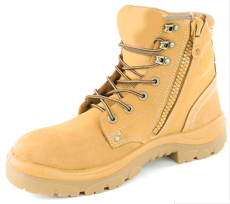
As farmers you spend a majority of your life on your feet so it’s important that we do what we can to look after them.
The best way that you can take care of your feet is to find the most comfortable work boot, that’s appropriate for your terrain and farm work.
You can apply a few general rules for footwear and adapt them to your work requirements.
Qualities to look for in a farm boot:
- Firm heel counter to support your heel and ankle. You should not be able to bend the back of the shoe down.
- Heel pitch: Boot’s should have a minimum of a 10mm heel pitch.
- Lace up with zip side: Lace up ensures a secure fit around ankle, and ability to loosen around forefoot for wider/narrower feet. The zip is purely for convenience. Significant movement of your foot in the boot means you haven’t got enough support.
- Toe cap: For protection of the forefoot, boot’s now have lighter toe cap options that won’t squash toes.
- Padded/cushioned sole: Greatly filters the shock and impact of walking, reducing the strain on your feet and legs.
- Width and depth: Make sure the shoe is wide enough so that your toe’s are not squashed, and likewise with the depth under the toe cap.
Shoe life:
Everyone wears through their shoes at different rates, so it’s important to consider how often you are wearing them, and what conditions you are wearing them in (rain, mud, water, chemicals). Both these factors will determine the life of your shoe. If you find after a period of time your feet are starting to ache and feel very sore at the end of the day it may be time to replace your work boots.
Safety boot suppliers have moved away from an elastic-sided boot to a lace-up boot, in favour of function, comfort, support and general foot health. The traditional elastic-sided boot provides little ankle support, and tends to get sloppy and loosen with time. There are many different brands and styles to choose from so it’s important you find the boot with all the above qualities and durability guarantee.
Socks:
Socks can also increase the comfort and health of your feet. Materials that are breathable are recommended as they help regulate the temperature of the foot better, and can reduce moisture on the skin if you’re prone to sweating. Try and find a good quality sock that is mostly made from wool and cotton (60%-70%) as they will be warmer, more breathable, more cushioned and durable. Try to avoid synthetic fabrics as they will encourage moisture and can leave your shoes feeling damp.
- If you need any further footwear advice or are suffering with foot, ankle, knee, or leg pain then seek advice from a podiatrist.
- You can find your local podiatrist in the yellow pages, or ask your preferred health professional or GP.
- Find a podiatrist.
- For specific brands and where to buy footwear consult your local podiatrist.
- If you have diabetes, have regular checks with your podiatrist and always check your shoes for foreign matter before putting them on.
Things to remember
- Shoes are for protecting the feet.
- A good shoe should feel comfortable straight away.
- If you spend most of your time in your work boots it’s important to replace them once they have worn out (anywhere between 12-24months).
Feet – problems and treatments
Foot and leg pain or injury can be caused by many things, including the pattern in which the feet and legs move during walking and other activities. Corns, calluses, bunions, tinea and papillomas are other foot problems that can be treated, usually with the help of a podiatrist. Correctly fitted shoes are also important.
Find out more about this topic at Better Health Channel
Fast facts:
- There is a strong correlation between ‘sore feet’ and poor footwear.
- As farmers you spend most of your day on your feet, so it’s very important that they are well looked after.
- The best way that can be achieved is through wearing the best work boot possible for you.
References used for this topic
More information:
Research & reviews:
Australasia Journal of Podiatric Medicine
Footwear Suitability Scale: A Measure of Shoefit for People with Diabetes
Reviewed by:
AHPRA Registration: POD0001863137
Provider No: 4770501B
|
|
